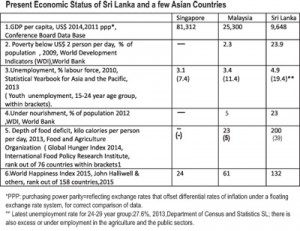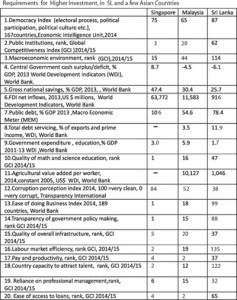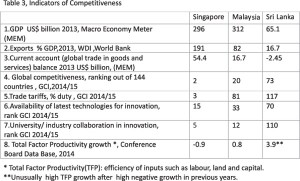2015 General Elections and the Economy: Some targets to be set for future MPs
When the history of the country is ultimately written, it will be clear how Sri Lanka (SL) has ‘missed the bus’ during the last 40 years or more (30 years of war + 10). This is mostly due to the fact that people themselves thought that there were more imortant things to be done than realising better standards of living in future; to ‘enjoy the fruits before the trees bore them’. In other words they thought that subsidies and welfare at the expense of the taxpayer were more important than savings, investment, hard work, etc. What is worse they ignored the fact that such effort needs unity of purpose and consensus among all the communities in the country and not racial and religious disharmony that distracts the nation from the desired path to peace and prosperity. At the bottom of this disastrous philosophy were the corrupt politicians interested in short-term political gains and not the wellbeing of the people.
 While Sri Lankans were busy with such wasteful activities and corruption, most of the South East Asian nations have speeded ahead, one after the other on account of an obsession with economic gains for the people on the part of their leaders and some practical strategies (as Deng of China said “it does not matter whether the cat is black or white as long as it catches mice”) and means to realize them. See Table 1 for details of SL’s performance vs that of Singapore or Malaysia. Singapore presents the ‘Wonder of Asia’ socio economic status/ targets that could be achieved taking about 30 to 40 years of effort, if SL could start improving right now. Malaysia, which gained independence a few years after SL, presents a midway set of targets that can be reached in a shorter time span if a start is made immediately adopting practical means without arguing about theories of economic development or engaging in destructive communal politics. Data in the tables in this paper could be used to indicate problem areas, targets for the parliamentarians and for monitoring of performance.
While Sri Lankans were busy with such wasteful activities and corruption, most of the South East Asian nations have speeded ahead, one after the other on account of an obsession with economic gains for the people on the part of their leaders and some practical strategies (as Deng of China said “it does not matter whether the cat is black or white as long as it catches mice”) and means to realize them. See Table 1 for details of SL’s performance vs that of Singapore or Malaysia. Singapore presents the ‘Wonder of Asia’ socio economic status/ targets that could be achieved taking about 30 to 40 years of effort, if SL could start improving right now. Malaysia, which gained independence a few years after SL, presents a midway set of targets that can be reached in a shorter time span if a start is made immediately adopting practical means without arguing about theories of economic development or engaging in destructive communal politics. Data in the tables in this paper could be used to indicate problem areas, targets for the parliamentarians and for monitoring of performance.
Two main determinants
Before the elections therefore, the people should know what instructions they could give their future representatives to create better livelihoods.
There are just two important determinants of higher earnings i.e. (a) higher investment for creation of employment opportunities especially in manufacturing for production of more goods and services and (b) greater (global/export) competitiveness in price and value terms for customers.
Then it is a matter of checking back on what factors determine higher investment as well as competitiveness. There is another pathway to prosperity that has not been tried out in SL, i.e. increasing farmer incomes (despite the fact that there are about 17 million people depending directly or indirectly on agriculture) by undertaking consolidation of fragmented and uneconomic farm holdings and re-plotting to improve access and ease of mechanisation. Both methods can be undertaken at the same time successfully as in Japan, Taiwan and South Korea, the latter’s semaul movement could be a good model.
For SL to realize a much better standard of living, the country needs to invest at least 35 per cent of GDP (US $75 billion in 2014) per annum continuously. Currently the level of domestic savings that can be invested is about 21 per cent of GDP. Therefore we need to attract about 14 per cent or more of GDP to fill the investment gap to create jobs especially for the youth (most of whom are abandoned after the GCE A Levels, without any skills, as only about 20 per cent enter the universities, to be picked up by the drug lords, criminal gangs, etc) and produce the goods and services the country needs domestically and for export. This additional investment should preferably be in the form of foreign direct investment (FDI), not only because of the scarcity of domestic investments but also due to the fact the FDI could bring in scarce technical and management expertise, access to global markets in addition to large amounts of foreign capital.

Table 2
By the way, since SL is a small country with a small domestic market, we cannot hope to increase incomes by producing only for the domestic market. The alternative left to earn more in foreign exchange to pay for imports and reduce our heavy external debt burden is to produce a larger scale for the larger export market and spread costs over a large volume of goods to reduce unit prices and adding value on the basis of customer needs.
Determinants of investment
SL needs to inspire confidence especially among FDIs that investors and their staff would be able to operate for a long period without being interrupted or harassed and are able to remit their profits. For this purpose SL has to build an enabling environment of socio-political stability along with leadership that is ‘obsessed’ with increasing incomes of the people plus good governance consisting of equal rights for all irrespective of race or religion, separation of powers as in the 19th Amendment, leading to efficient and effective public institutions, (particularly an independent judiciary and the police capable of maintaining law and order), staffed by competent officials selected on merit alone as Singapore did, and not inefficient and corrupt political stooges as SL opted for especially in the past 10 years.
The other requirement is budgetary and monetary stability with low budget deficits leading to low inflation capable of reducing costs of production, lowering interest rates to motivate businesses to borrow freely and a flexible exchange rate regime to ensure the exchange rate is neither overvalued (as it would mean lower earnings by way of rupees for exporters) nor an undervalued rate (as it would tend to increase the prices of imports for domestic consumers). In addition the policies and incentives adopted by the government should be transparent and predictable without sudden changes as in the past; government should also make a consistent attempt to simplify procedures and documentation which is now quite complex especially with regard to the labour market. Effective action should also be taken to eliminate widespread corruption (more than 9 per cent of GDP as reported by the Sri Lanka Economic Association, in 2007, after which it may have shot up and reduced growth drastically) to the extent of even demanding bribes from investors. Government in addition needs to reform and develop our outdated system of education to produce sufficient technical and soft skills (such as creativity, communication preferably in English, ability to work as a team, solve problems and achieve targets of growth, etc) which are currently very scarce, while ensuring world class infrastructure facilities like paved roads, adequate electricity and water supplies, (functioning) ports, airports, ICT facilities, and social protection for those in acute poverty and the disabled. Last but not least the government as well as the businesses have to ensure much better levels of professional management and productivity by way of higher output and returns from the inputs of factors of production such as labour, capital and especially land where according to available data low agricultural productivity in SL is responsible for hunger and malnutrition especially among children and expectant mothers. See Table 2.

Table 3
Determinants/Indicators of global Competitiveness
Finally we should work backwards and examine the determinants of global competitiveness. They are uniformly low import duties and other levies (essential items e.g. food for domestic consumption may have to be given a degree of protection) which could pressurise businesses to compete with each other both in the domestic and global spheres to lower their costs by adopting large scale production and adding value in a unique way or differentiating them on the basis of the customer needs by adopting innovative practices. Such a strategy will also enable firms to avoid competition and ensure higher returns. SL cannot hope to realize such a situation through import substitution/protection of firms by imposing high import duties and levies as we did during the last 10 years. Such firms would argue . ‘why waste time and money innovating to export we are already making good profits producing for the domestic market?’ See Table 3 for indicators of competitiveness.
Engine of growth
Thus the simple formula for growth of real incomes is to invest in production of goods and services for the world market and be globally competitive. The ‘engine of growth’ is the private sector. If a private business does not operate efficiently to generate profits it will go bankrupt. Therefore it is compelled to be efficient at all times.
State-owned enterprises (SOEs) would be incapable of doing it mainly because appointments are made on a political basis and not on professional merit. Accompanying corruption would result in diversion of funds as seen in the past 10 years. The taxpayers money will be sucked in continuously to keep the loss-making SOEs going. For the same reasons they will not be export competitive and therefore the people will not benefit. Besides deciding on suitable policies/incentives and maintaining law and order, the main function of the state is to invest as in the case of the high performing East Asian nations, in quality infrastructure facilities and services such as health and education. These are areas that the private sector avoids investing in. This formula has to be adopted continuously like in Malaysia and Singapore, without experimentation.
This is basically the advice that should be given to our future parliamentarians, while giving them targets and indicating problem areas, since it is only such a system that will deliver higher real incomes as demonstrated even by communist China. (The writer is an economist)


